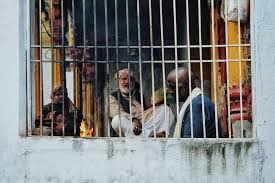The Long Fight for Accessibility and Dignity in Indian Prisons (GS Paper 2, Governance)

Context:
- The article sheds light on the systemic neglect and inaccessibility faced by disabled prisoners in India, with a focus on the case of Professor G.N. Saibaba.
- Despite legal safeguards and international commitments, Indian prisons continue to fail in ensuring humane treatment for prisoners, especially those with disabilities.
- This highlights the urgent need for prison reforms to uphold prisoners' constitutional and disability rights.
Historical Context of Indian Prisons
- Indian prisons have long been associated with violence, neglect, and human rights abuses.
- One of the most notorious examples of systemic cruelty occurred in the Bhagalpur blindings (1979-80), where prisoners were blinded by police.
- Efforts to reform the prison system have been insufficient, as illustrated by the Mulla Committee report of the 1980s, which recommended comprehensive reforms but was largely ignored.
- The Supreme Court’s intervention in the 1996 case of Rama Murthy vs State of Karnataka led to directives on issues like overcrowding, trial delays, and torture, but meaningful improvements have remained limited.
The Tragic Case of Prof. G.N. Saibaba
- Background: Prof. G.N. Saibaba was a renowned English professor at Delhi University and a prominent social justice activist advocating for tribal rights.
- Health and Disability: Saibaba suffered from 90% physical disability due to post-polio paralysis and was wheelchair-bound.
- Arrest and Charges: He was arrested in 2014 under the Unlawful Activities (Prevention) Act (UAPA) for alleged links to Maoist groups.
- Imprisonment: Saibaba was held in Nagpur Central Jail under inhumane conditions, facing severe challenges due to the lack of accessible facilities for disabled prisoners.
- Exoneration: He was acquitted in March 2024 after spending nearly a decade in prison.
- Death: Tragically, he passed away in October 2024, just months after his release, highlighting the human rights violations in Indian prisons.
- Legacy: Saibaba’s case brought to light the dire issues of accessibility, neglect, and violations of prisoners’ rights in the Indian penal system.
Current State of Indian Prisons
- Overcrowding: Indian prisons are severely overcrowded, with 5.73 lakh inmates housed in facilities meant for only 4.36 lakh. Some jails are operating at more than 200% capacity (NCRB, 2022).
- Conditions for Disabled Prisoners: Prison conditions are particularly harsh for disabled prisoners, who face neglect, inadequate infrastructure, and abuse. The government lacks comprehensive data on disabled prisoners, but high-profile cases such as that of Father Stan Swamy, who had Parkinson’s disease, show the severe challenges they face. Swamy was denied basic necessities, such as a straw or sipper, making simple activities impossible.
Accessibility Issues in Prisons
- Disabled prisoners face systemic inaccessibility to essential prison facilities, including cells, toilets, meeting rooms, and recreational areas.
- A 2018 audit of Delhi’s Tihar, Rohini, and Mandoli jails by the Nipman Foundation revealed that there was a lack of functional wheelchairs and proper accessible infrastructure, which further hindered the ability of disabled prisoners to live with dignity.
Legal and International Obligations
- Prisoners in India are entitled to dignity, equality, and freedom under the Indian Constitution, as upheld by the Supreme Court in Upendra Baxi vs State of U.P. (1983).
- Moreover, international conventions, such as the Nelson Mandela Rules (2015) and the UN Convention on the Rights of Persons with Disabilities, mandate that prisoners, especially disabled ones, must be treated humanely and provided with adequate accessibility.
- The Rights of Persons with Disabilities Act, 2016, requires protection from abuse and ensures basic necessities are provided.
- These rights were clearly violated in the case of Father Stan Swamy.
- Further, the Ministry of Home Affairs’ Model Prison Manual (2016) and the Accessibility Guidelines (2024) outline the need for prisons to be accessible.
- However, despite these provisions, the implementation of these guidelines has been weak, and there are still significant gaps in ensuring compliance with these legal requirements.
Conclusion: Lack of Political Will and Need for Reform
- The lack of political will to address prisoner welfare, particularly that of disabled prisoners, has led to the continued neglect of their rights.
- While Indian prisons remain under the state’s responsibility, the failure to adhere to laws and provide humane treatment is a glaring violation of constitutional obligations.
- Reforms are urgently needed to address the systemic neglect and abuse, and state governments must act to ensure humane conditions and accessibility within prisons to prevent further tragedies like that of Prof. Saibaba.
- The situation calls for more than just legal declarations; it requires genuine political commitment to overhaul the prison system, making it more accessible, accountable, and compassionate towards all prisoners, including those with disabilities.
- Without such reforms, the rights of prisoners will continue to be ignored, perpetuating the cycle of abuse and neglect within the prison system.


